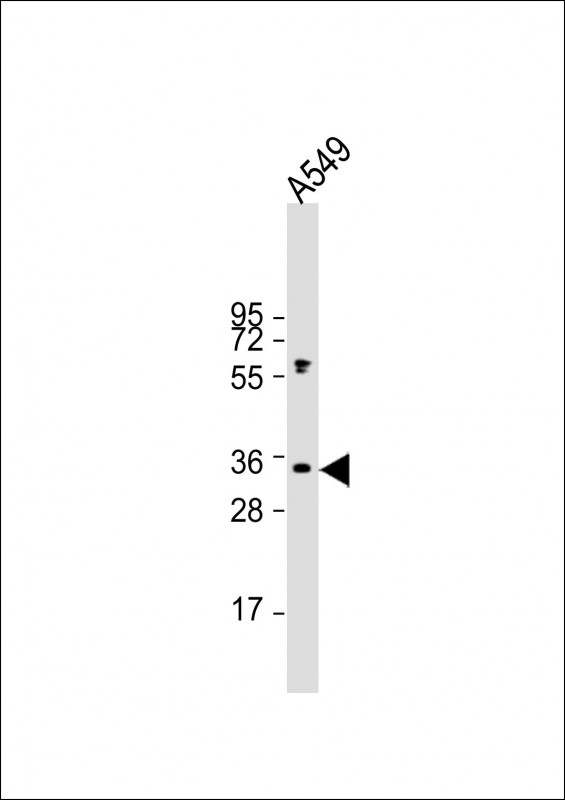ORAI1 Antibody (C-term)
Affinity Purified Rabbit Polyclonal Antibody (Pab)
- 产品详情
- 实验流程
- 背景知识
Application
| WB, E |
|---|---|
| Primary Accession | Q96D31 |
| Other Accession | NP_116179.2 |
| Reactivity | Human |
| Host | Rabbit |
| Clonality | Polyclonal |
| Isotype | Rabbit IgG |
| Calculated MW | 32668 Da |
| Antigen Region | 269-298 aa |
| Gene ID | 84876 |
|---|---|
| Other Names | Calcium release-activated calcium channel protein 1, Protein orai-1, Transmembrane protein 142A, ORAI1, CRACM1, TMEM142A |
| Target/Specificity | This ORAI1 antibody is generated from rabbits immunized with a KLH conjugated synthetic peptide between 269-298 amino acids from the C-terminal region of human ORAI1. |
| Dilution | WB~~1:1000 E~~Use at an assay dependent concentration. |
| Format | Purified polyclonal antibody supplied in PBS with 0.09% (W/V) sodium azide. This antibody is purified through a protein A column, followed by peptide affinity purification. |
| Storage | Maintain refrigerated at 2-8°C for up to 2 weeks. For long term storage store at -20°C in small aliquots to prevent freeze-thaw cycles. |
| Precautions | ORAI1 Antibody (C-term) is for research use only and not for use in diagnostic or therapeutic procedures. |
| Name | ORAI1 {ECO:0000303|PubMed:16921383, ECO:0000312|HGNC:HGNC:25896} |
|---|---|
| Function | Pore-forming subunit of two major inward rectifying Ca(2+) channels at the plasma membrane: Ca(2+) release-activated Ca(2+) (CRAC) channels and arachidonate-regulated Ca(2+)-selective (ARC) channels (Probable) (PubMed:16645049, PubMed:16733527, PubMed:16807233, PubMed:16921383, PubMed:19249086, PubMed:19706554, PubMed:23307288, PubMed:26956484, PubMed:28219928). Assembles with ORAI2 and ORAI3 to form hexameric CRAC channels that mediate Ca(2+) influx upon depletion of endoplasmic reticulum Ca(2+) store and channel activation by Ca(2+) sensor STIM1, a process known as store-operated Ca(2+) entry (SOCE). Various pore subunit combinations may account for distinct CRAC channel spatiotemporal and cell-type specific dynamics. ORAI1 mainly contributes to the generation of Ca(2+) plateaus involved in sustained Ca(2+) entry and is dispensable for cytosolic Ca(2+) oscillations, whereas ORAI2 and ORAI3 generate oscillatory patterns. CRAC channels assemble in Ca(2+) signaling microdomains where Ca(2+) influx is coupled to calmodulin and calcineurin signaling and activation of NFAT transcription factors recruited to ORAI1 via AKAP5. Activates NFATC2/NFAT1 and NFATC3/NFAT4-mediated transcriptional responses. CRAC channels are the main pathway for Ca(2+) influx in T cells and promote the immune response to pathogens by activating NFAT-dependent cytokine and chemokine transcription (PubMed:16582901, PubMed:17442569, PubMed:19182790, PubMed:20354224, PubMed:22641696, PubMed:26221052, PubMed:32415068, PubMed:33941685). Assembles with ORAI3 to form channels that mediate store-independent Ca(2+) influx in response to inflammatory metabolites arachidonate or its derivative leukotriene C4, termed ARC and LRC channels respectively (PubMed:19622606, PubMed:32415068). Plays a prominent role in Ca(2+) influx at the basolateral membrane of mammary epithelial cells independently of the Ca(2+) content of endoplasmic reticulum or Golgi stores. May mediate transepithelial transport of large quantities of Ca(2+) for milk secretion (By similarity) (PubMed:20887894). |
| Cellular Location | Cell membrane; Multi-pass membrane protein. Basolateral cell membrane {ECO:0000250|UniProtKB:Q8BWG9}; Multi-pass membrane protein. Note=Upon store depletion, colocalizes with STIM1 in membrane punctae at ER-PM junctions (PubMed:19182790, PubMed:19249086, PubMed:26221052, PubMed:27185316) [Isoform beta]: Cell membrane |
| Tissue Location | Expressed in naive CD4 and CD8 T cells (at protein level) (PubMed:26956484). Expressed at similar levels in naive and effector T helper cells (PubMed:20354224) |
For Research Use Only. Not For Use In Diagnostic Procedures.
Provided below are standard protocols that you may find useful for product applications.
BACKGROUND
CRACM1 is a plasma membrane protein essential for store-operated calcium entry (Vig et al., 2006 [PubMed 16645049]).
REFERENCES
Feng, M., et al. Cell 143(1):84-98(2010)
Kawasaki, T., et al. J. Biol. Chem. 285(33):25720-25730(2010)
Motiani, R.K., et al. J. Biol. Chem. 285(25):19173-19183(2010)
Zhou, Y., et al. Proc. Natl. Acad. Sci. U.S.A. 107(11):4896-4901(2010)
Bogeski, I., et al. Sci Signal 3 (115), RA24 (2010) :
终于等到您。ABCEPTA(百远生物)抗体产品。
点击下方“我要评价 ”按钮提交您的反馈信息,您的反馈和评价是我们最宝贵的财富之一,
我们将在1-3个工作日内处理您的反馈信息。
如有疑问,联系:0512-88856768 tech-china@abcepta.com.























 癌症的基本特征包括细胞增殖、血管生成、迁移、凋亡逃避机制和细胞永生等。找到癌症发生过程中这些通路的关键标记物和对应的抗体用于检测至关重要。
癌症的基本特征包括细胞增殖、血管生成、迁移、凋亡逃避机制和细胞永生等。找到癌症发生过程中这些通路的关键标记物和对应的抗体用于检测至关重要。 为您推荐一个泛素化位点预测神器——泛素化分析工具,可以为您的蛋白的泛素化位点作出预测和评分。
为您推荐一个泛素化位点预测神器——泛素化分析工具,可以为您的蛋白的泛素化位点作出预测和评分。 细胞自噬受体图形绘图工具为你的蛋白的细胞受体结合位点作出预测和评分,识别结合到自噬通路中的蛋白是非常重要的,便于让我们理解自噬在正常生理、病理过程中的作用,如发育、细胞分化、神经退化性疾病、压力条件下、感染和癌症。
细胞自噬受体图形绘图工具为你的蛋白的细胞受体结合位点作出预测和评分,识别结合到自噬通路中的蛋白是非常重要的,便于让我们理解自噬在正常生理、病理过程中的作用,如发育、细胞分化、神经退化性疾病、压力条件下、感染和癌症。






